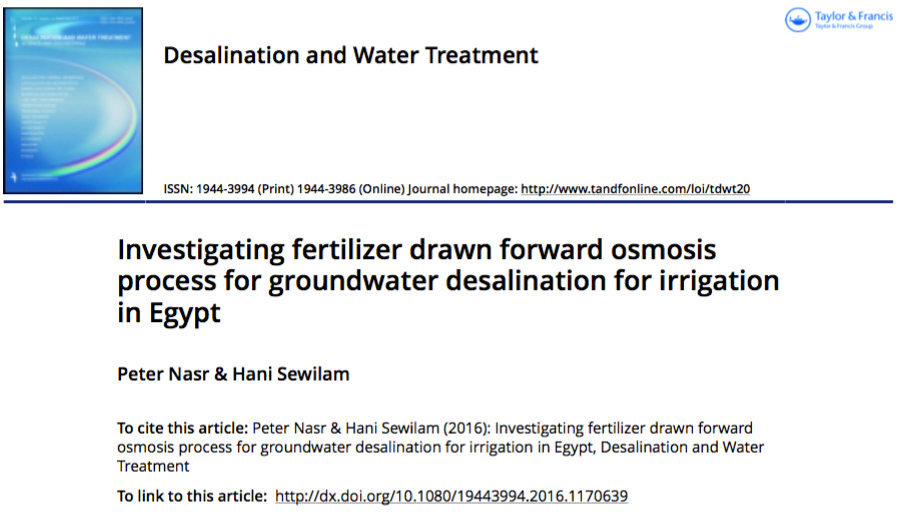FDFO for groundwater desalination
 Groundwater desalination could be a possible solution to Egypt’s scarcity problem through applying state-of-the-art desalination technologies. More than half of Egypt’s area has access to brackish groundwater, 47% of which has access to aquifers with moderate to high potential for development.
Groundwater desalination could be a possible solution to Egypt’s scarcity problem through applying state-of-the-art desalination technologies. More than half of Egypt’s area has access to brackish groundwater, 47% of which has access to aquifers with moderate to high potential for development.
This work investigated a recently developed desalination technology, which is Fertilizer Drawn Forward Osmosis (FDFO). In this process, concentrated fertilizer solution is used as the draw solute. Two different solutions are used in the FDFO process: saline water (as the feed solution, FS) on one side of the membrane, and highly concentrated fertilizer solution (as the draw solution, DS) on the other side of the membrane. The two solutions are always kept in contact with the membrane through a counter current flow system, where fresh water flows from the saline feed solution towards the highly concentrated fertilizer draw solution. After extracting the water by the FO process, the fertilizer draw solution becomes diluted and thus can be used directly for fertigation, avoiding the need for separation and recovery of the DS.
Introduction to the research work
In this work, ammonium sulphate was selected as a draw solution being a commercial, inexpensive and efficient Egyptian fertilizer. Three commercially available Forward Osmosis (FO) membranes were tested for baseline flux. Best membrane was selected for further experimentation. A real Egyptian brackish groundwater sample from El Tor in Sinai was used as the feed solution. Performance has been assessed by the water flux, reverse permeation and the forward rejection of the feed solutes. Porifera’s commercial FO membrane proved to be the best membrane with respect to baseline flux. It was chosen for further experimentation.
Water flux and ammonium sulphate concentration can be correlated logarithmically. Further increase in ammonium sulphate concentration decreases water flux gradually due to increased severity of concentration polarization effects that take place at high draw solution concentration. Specific Reverse Solute Flux (SRSF) values did not exceed 0.18 g/l for both NH4+ and SO42- ions, indicating high membrane selectivity. At flux exceeding 20 Lm-2h-1, NH4+ ion reported higher SRSF values than that of SO42− ion, a phenomenon that could be attributed to thermodynamic influence. SRSF is almost constant irrespective of ammonium sulphate concentration.
While increasing draw solution concentration lead to increasing Na+ ion rejection, it caused a significant decline in Cl– ion rejection. This phenomenon could be probably associated to an ion exchange mechanism and the membrane surface charge.
Conclusions
In conclusion, the scheme studied showed that ammonium sulphate is an efficient draw solution for FDFO process using Porifera’s commercial FO membrane exhibiting high osmotic pressure, low reverse solute permeation and remarkable rejection of feed solute.

